
Features
Mills
Sawmilling
Wood Panels
A one-stop shop: C&C Wood Products stays ahead of the curve
December 4, 2019 By Ellen Cools
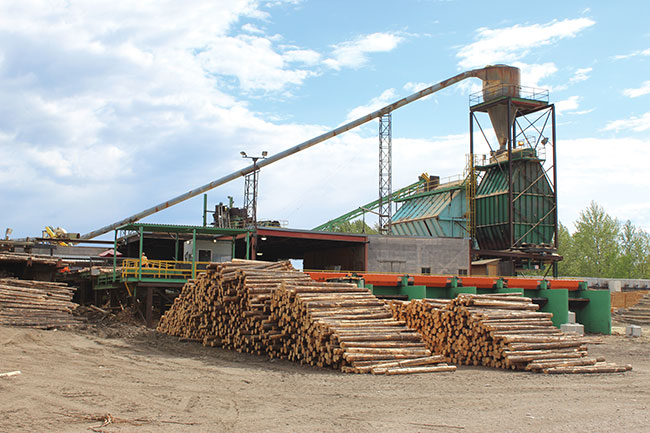 The lumber yard and sawmill at Quesnel, B.C.-based C&C Wood Products. Photo: Annex Business Media
The lumber yard and sawmill at Quesnel, B.C.-based C&C Wood Products. Photo: Annex Business Media
The B.C. forest industry has had a rough year – many mills have shut down as available timber supply dwindled and market conditions remained uncompetitive. But there is a silver lining: the contraction of the industry has led to more and more conversations about the benefits and importance of value-added, specialty products.
Quesnel, B.C.-based C&C Wood Products is ahead of the curve. The company has been producing specialty wood products since it began in 1987, and recently began producing multi-laminate timber using recovered wood.
The company has remained competitive in the marketplace by carving out a niche for themselves, using as much wood as possible to produce their value-added products.
From forest to finished products
C&C Wood Products also prides itself on executing every step of the process, from logging to laminating, and all the sawmilling, kiln drying and finger jointing in between.
It’s a fully-integrated process, from forest to the finished products, CEO Dimitrios Leonidas explains.
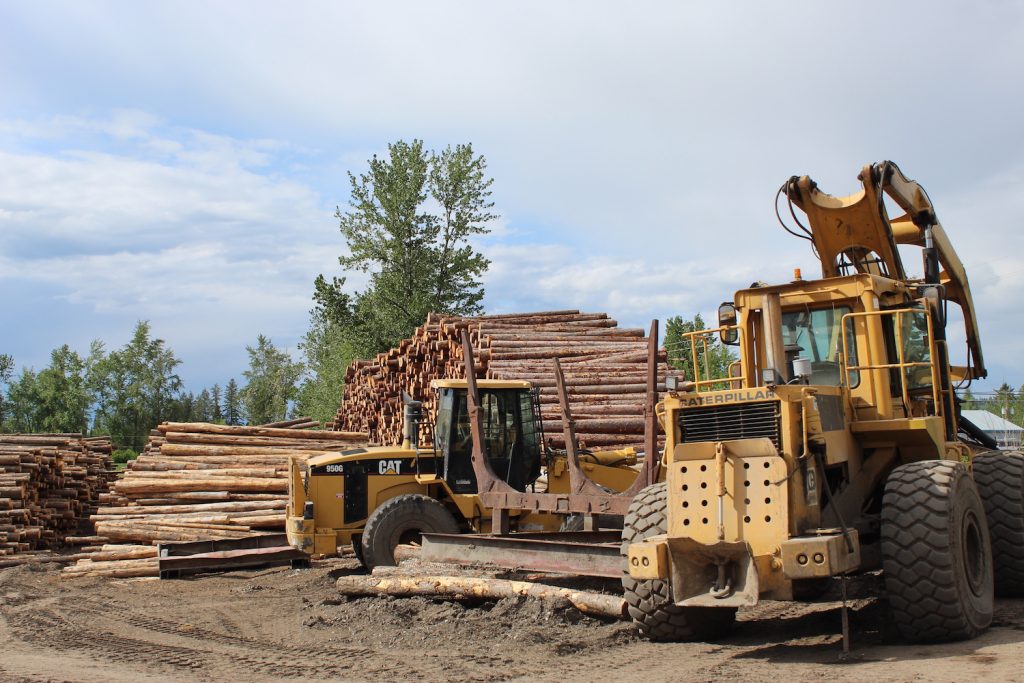
C&C Wood Products harvests 250,000 cubic metres of SPF annually, in 16- and 20-foot logs.
On the harvesting side, the company does cut-to-length logging, cutting 250,000 cubic metres of SPF annually, which matches the amount they can effectively put through their sawmill. Their harvesting equipment includes Hitachi ZX210F processors, Tigercat 870C feller bunchers, John Deere 748H skidders and a Hitachi ZX310F button top loader.
Most of the logs come from open market buying or through working partnerships with First Nations, Leonidas explains. Some of it comes from the company’s non-renewable forest license in the western half of the Quesnel Forest District.
“The logs from the forest come in as 16-foot and 20-foot logs,” he says. “Logs are bucked to eights and tens and sorted for diameter and other attributes.”
C&C Wood Products also does its own log hauling, using Kenworth T8009 logging trucks with Aspen 55T-TRI-Hyrdualic low bed trailers.
The logs then go to the sawmill, where they first go through a Cambio drum debarker, then to a McGehee Equipment Co. canter with a McGehee single-arbour resaw. The lumber is then sent to two Moore dry kilns.
Afterwards, the lumber goes to one of two Wadkins surfacing machines to produce the finished products. The Wadkins machines are “very reliable,” Leonidas says. Overall, the company produces 30 mmbf per year.

Dried lumber heads to the Wadkins surfacing machines to produce the finished products.
Value recovery is key
C&C Wood Products produces multiple specialty products, including interior thin paneling and thin shiplap. The thin paneling is a natural-coloured wall panel product. After going through one of the Wadkins machines, it goes on to one of three manufacturing to pattern lines. The thin shiplap/plant line uses four-foot recovery wood, painted in one of eight market-driven colours. The installation of a RazorGage saw system and custom-built automated packaging has allowed C&C to expand its market for these products.
The company recently purchased a shuttered finger joint plant in Cranbrook, B.C., which had been closed for 10 years, to produce engineered siding and trim.
“It was a plant designed and built to make finger joint studs, so we have taken that and we’re adding the equipment to be able to make finger jointed edge-glued siding and trim products, just extending the manufacturing process to make a higher-value product,” Leonidas explains.
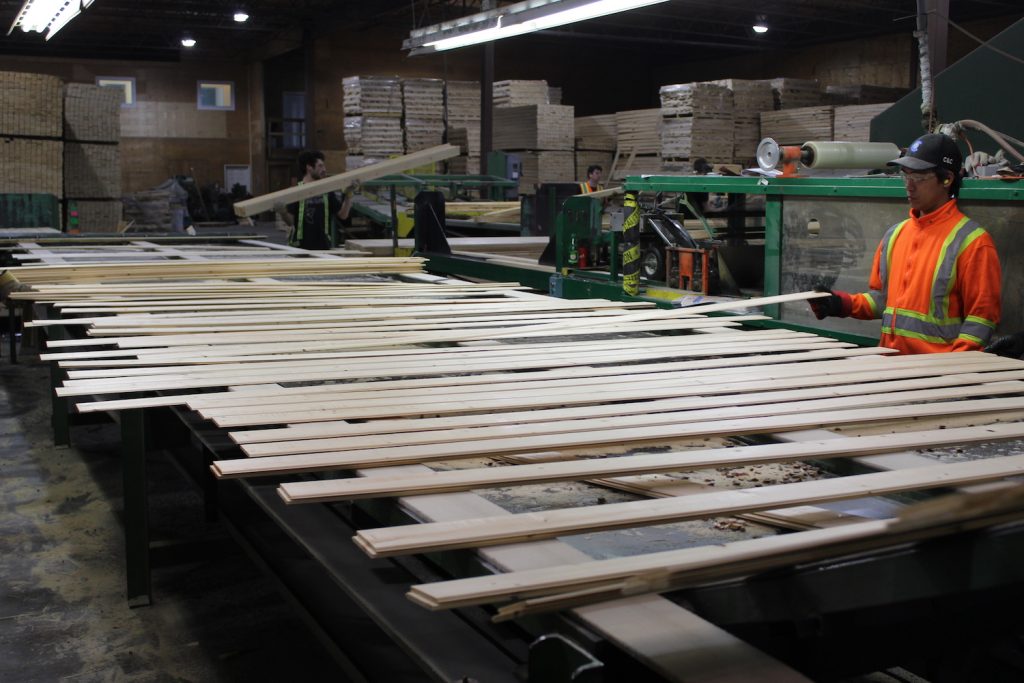
To produce these higher value products, the company invested in Ultimizer chop saws, a Conception finger jointer, a Mann-Russell continuous RF press, a Weinig moulder, a Holytek moulder and a Robinson resaw, along with two custom-built Stanza vacuum coat paint machines.
The company also recently decided that there was an opportunity to expand and develop a new product line: structurally rated post and beams. This multi-laminate timber product is produced using only recovered wood.
“There’s a portion of the log mix that comes out of dead standing logs that doesn’t necessarily suit all the appearance-grade products, but for making structural posts it works very well,” Leonidas explains.
“We’re able to take that product and finger joint, edge glue and face glue that specific grade of lumber into the finished product.”
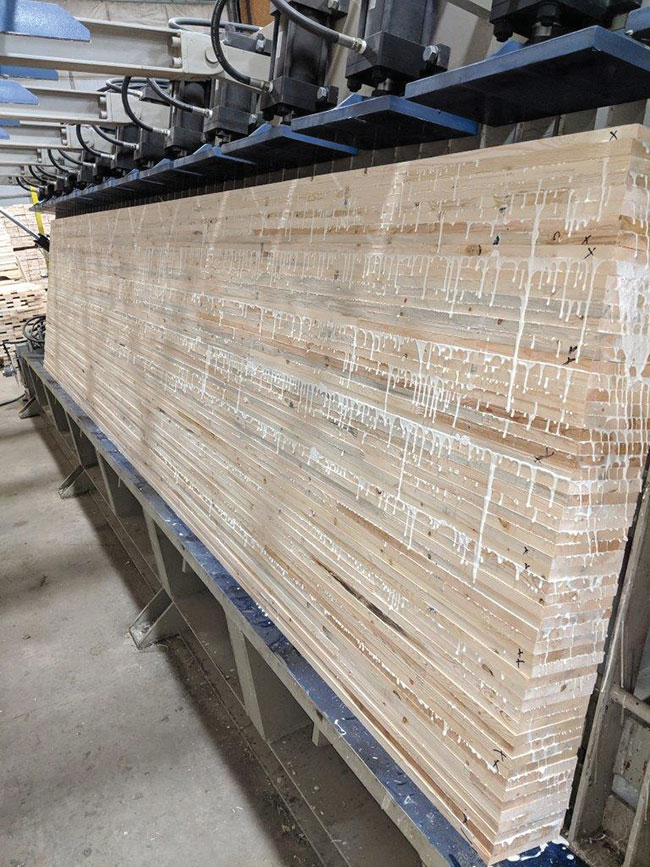
Recovered wood goes through a Quick Manufacturing press to make C&C’s multi-laminate timber product, structurally-rated post and beams. Photo courtesy C&C Wood Products.
The products themselves range in size from 4×4 to 12×12, up to 20-feet long, and can be natural wood colour or painted. They are primarily for outdoor living space and custom-built homes. Unique to C&C, these beams are structural certified in all-axes by Timber Products Inspection Conyers Georgia.
The Quesnel plant, where the structural beams and posts are made, features a Conception finger jointer, RFS edge gluer, custom-built post press, a Quick Manufacturing press, Northfield surfacer, a Camtech ripsaw, and a West Plains resaw, Leonidas says.
This trend towards mass timber products, such as multi-laminate timber, recovers a formerly wasted resource while supporting the environment by sequestering carbon.
“It’s utilization of our forests and a step up from commodity manufacturing. It’s a technical end product, so it’s going to raise the bar in terms of Canada’s ability to produce engineered wood products on the world stage,” Leonidas explains.
Minimizing waste
These products are produced using small diameter logs, and there’s a good reason for that, Leonidas says.
“In keeping waste to a minimum, we do a lot of finger jointing and edge gluing, and it allows us to recover even the smallest pieces down to five inches long, three inches wide, and one inch thick, and build up our products from there. It’s our way of competing in the marketplace,” he explains.
“We’re not big enough to make commodity lumber effectively, but we are very good at taking small pieces of wood and building them up to a wide range of products.”
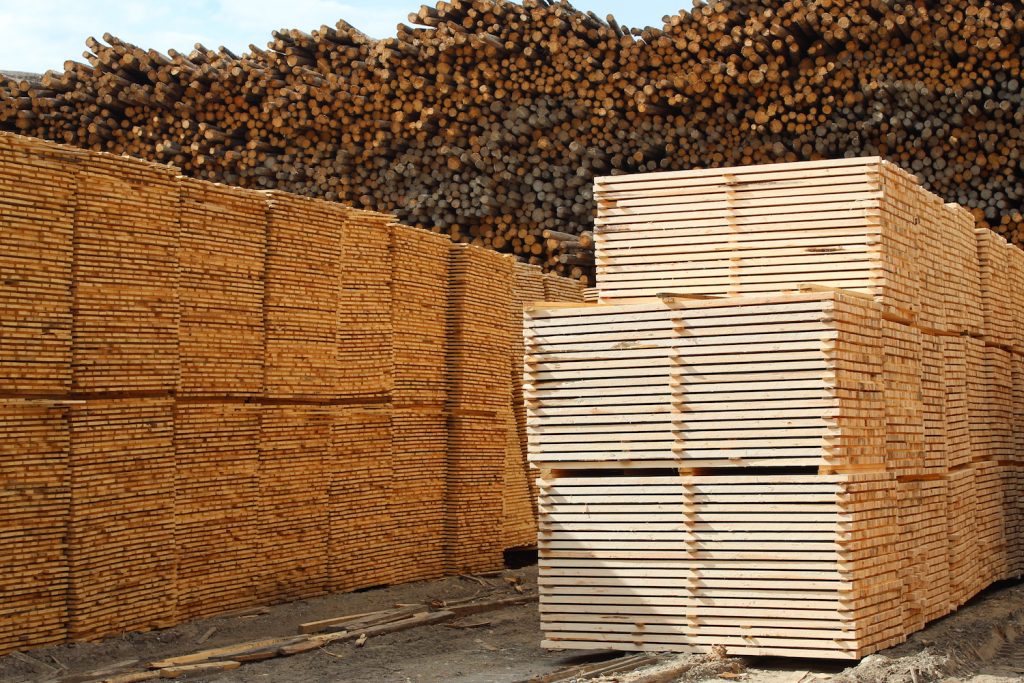
C&C Wood Products is a fully-integrated company, managing everything from the forest to the finished products.
For C&C Wood Products, being sustainable is key. The company has a PEFC (Programme for the Endorsement of Forest Certification) sustainable forest management certification, which means it manages its forests in line with challenging environmental, social and economic requirements.
Sustainability is “very important,” Leonidas says. “You see it in our company in the fact that we found a complete product line to be able to use and recover good value from dead standing trees, where in its alternate form, it might be feedstock for pellets or low-quality chips.”
Any part of the log that the company cannot use to create value-added products becomes a biomass product.
“Anything that’s smaller than our smallest diameter that we can effectively put through the mill, those pieces get debarked through the drum debarker and then go through our Morbark chipper,” Leonidas explains. “We participate in the biomass end of it because we’re dealing with a very small diameter log as our main diet, and, as a result, we do make a lot of biomass products, both for the pellet producers as well as for the nearby Quesnel River Pulp and Cariboo Pulp and Paper mills and to WestPine MDF, across the street from us.”
Altogether, the company produces 16,000 BDT (bone dry ton) of hog, 34,000 BDT of chips and 7,400 BDT of clean shavings.
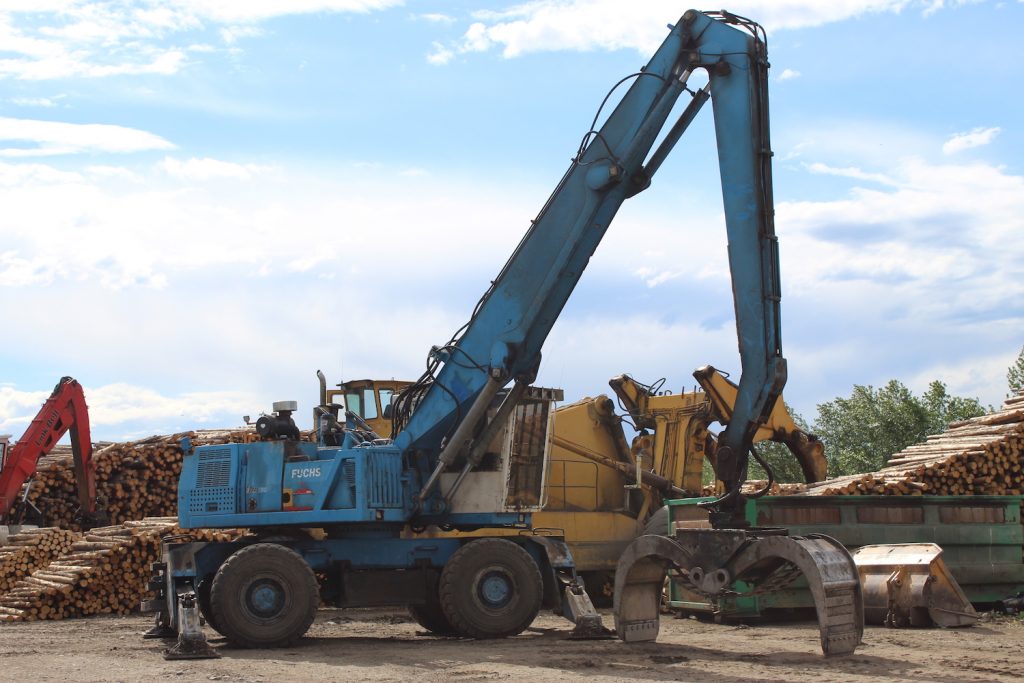
Any part of the log that the company cannot use to create value-added products becomes a biomass product.
Opportunities and challenges abound
And the company has no plans to slow down in the near future. There are many projects in the pipeline, but “we can’t share them just yet,” Leonidas says, laughing.
“In general, we’re looking for opportunities. We’re always looking at what’s in the fibre, in the logs, in the area that we operate, and we take that fibre quality and we pair that with end market and our product line ranges – products that are as thin as one-third of an inch all the way up to products that are 12-inches thick,” he elaborates.
In the next couple of years, Leonidas sees C&C Wood Products becoming a “bigger and stronger company than we are today.
“I think our product lines lend themselves to the consumer markets that we participate in,” he continues. “We see an opportunity to grow our volumes and certainly our brands, and I think with our very good, dedicated, safe workforce, that we can meet the demand that’s coming.”
But Leonidas admits that, like anyone else in the forest industry, the company is facing a number of challenges.
“It’s a competition for raw material, competition in the marketplace – just competition every day,” he says.
“Peak bug kill has passed, and now we’re on the downhill side of it, so there’s less and less,” he continues. “That affects the land base, and there’s the timber supply review upcoming in this area. So, certainly there’s less trees to be harvested – green or dead – in the Quesnel area, and we’re commenting on it; we’re making recommendations to the government, and I think it’ll affect every operator in the region.”
The wildfires in the past couple of years also affected the company greatly, although this year provided somewhat of a break for the region.
“A portion of our product lines will allow for the input of burned trees, but the overall supply reductions from wildfires is significant,” Leonidas says.
Given these challenges, Leonidas believes that more effort will have to be spent managing forests, particularly when it comes to monitoring the growth of newly planted trees. Debris needs to be reduced and adequate spacing is required to reduce the likelihood of large fires sweeping through the forests.
In Interior B.C., given the timber supply reviews and reduction in dead standing trees, Leonidas predicts a further contraction of the industry.
“But I think with the size of the land base and the average growing rates of trees in the area, there will always be trees growing and there will always be a need to make products out of the forest,” he says. “The trees will continue to grow. There will always be a forest products industry in British Columbia.”
Print this page